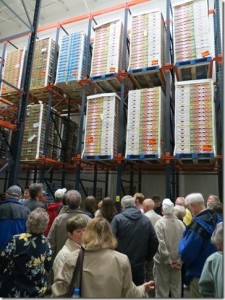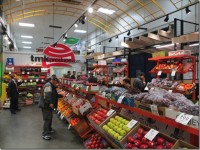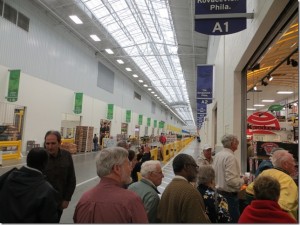Welcome to the Future of Fresh. This is an appropriate introduction to Philadelphia Wholesale Produce Market. There has been a wholesale market in Philadelphia for 300 years but the new market completed in June 2011 is the largest, fully-refrigerated wholesale marketplace in the world.
The tour of the Market and Port for almost 50 PSPA members and their guests was organized by the incredibly knowledgeable and passionate Dominic O’Brien of the Philadelphia Regional Port Authority. Dan Kane, Manager of the Produce Market, showed us some of the merchant bays and their wide range of produce.
Produce consigned to merchants from across the country and from around the world arrives and is unloaded for storage and sale in the totally covered market. The produce is immediately stored at 50°F to preserve freshness and ensure food safety. Within 2-4 days the purchased produce is in stores, food service establishments and restaurants. We saw peppers, sweet corn, onions, apples, pineapples and grapes.
The 25 independent fresh fruit and vegetable merchants have their own leased space for the produce they have acquired which is sold to supermarket chains and food service companies like Sysco local wholesalers, restaurants and home cooks, up. Some of the merchant families are fourth generation.
U.S. Customs and Agriculture Inspectors ensure that produce is safe and all imports are checked by Homeland Security. The huge 700,000 sq. ft. facility is superbly planned, spacious, and busy and sanitation is clearly exceptional as they claim.
It was impossible not to be impressed and grateful that we have such a facility supplying produce to our region so efficiently. How lucky we are and our group was grateful for the chance to learn about the Market and actually see it in operation.
The Port of Philadelphia was our next visit. We were all impressed by the scale of the operations which we pass as we hurtle along the 95 on our way north but have no idea of the large scale and sophistication of the operations in the 112 acres. The port is the eastern gateway for importing fresh fruit and vegetables – #1 in the country for handling perishables and many other items. 70% of the goods handled are imports and 30% exports.
Philadelphia is within a day’s drive of 50% of the nation’s population and 50% of US manufacturing lies within a two day drive. The Port Authority has been actively developing and promoting the facilities and excellent location. Double digit growth in cargoes handled has occurred in each of the last four years.
We drove in our very modern and comfortable bus past Hyundai and Kia cars which were parked ready to be transported to showrooms – 160,000 last year. We mainly toured the port’s largest facility, the Packer Avenue Marine Terminal, for containers, steel and perishables. We drove through a forest of stacked containers avoiding some of the 11 top loaders and 100 forklifts used at the port for moving and loading the containers on to trucks.
No ships were docked at our visit but we could see the giant equipment for loading and unloading containers from the ships. Operators are very highly skilled and deserve their high pay – over $100,000 a year.
Dredging of the Delaware will increase the depth from 40ft to 45ft and so allow larger ships to dock so allow all but the latest tallest container ships to access the port. Dredging should be complete by 2017.
 Our passionate and knowledgeable guide, Dominic O’Brien, pointed out that the port is responsible for lots of jobs. The port is unionized and generally highly paid and has the highest level of marine productivity on the East Coast. He also emphasized the importance of all the associated activities – transportation, storage, refrigeration, processing, and packaging. The port is served by three Class 1 railroads – CSX, Norfolk Southern and Canadian Pacific and 400 truckers compete for business. The I-95, 76 and 276 are adjacent and there is ready access to the New Jersey and Pennsylvania Turnpike.
Our passionate and knowledgeable guide, Dominic O’Brien, pointed out that the port is responsible for lots of jobs. The port is unionized and generally highly paid and has the highest level of marine productivity on the East Coast. He also emphasized the importance of all the associated activities – transportation, storage, refrigeration, processing, and packaging. The port is served by three Class 1 railroads – CSX, Norfolk Southern and Canadian Pacific and 400 truckers compete for business. The I-95, 76 and 276 are adjacent and there is ready access to the New Jersey and Pennsylvania Turnpike.
It was impossible not to be impressed by the infrastructure that is required to transport safely and rapidly the huge range of perishable and non-perishable goods arriving every day from around the world that our modern life demands.
Notes by Duncan Allison – 5/28/2014


